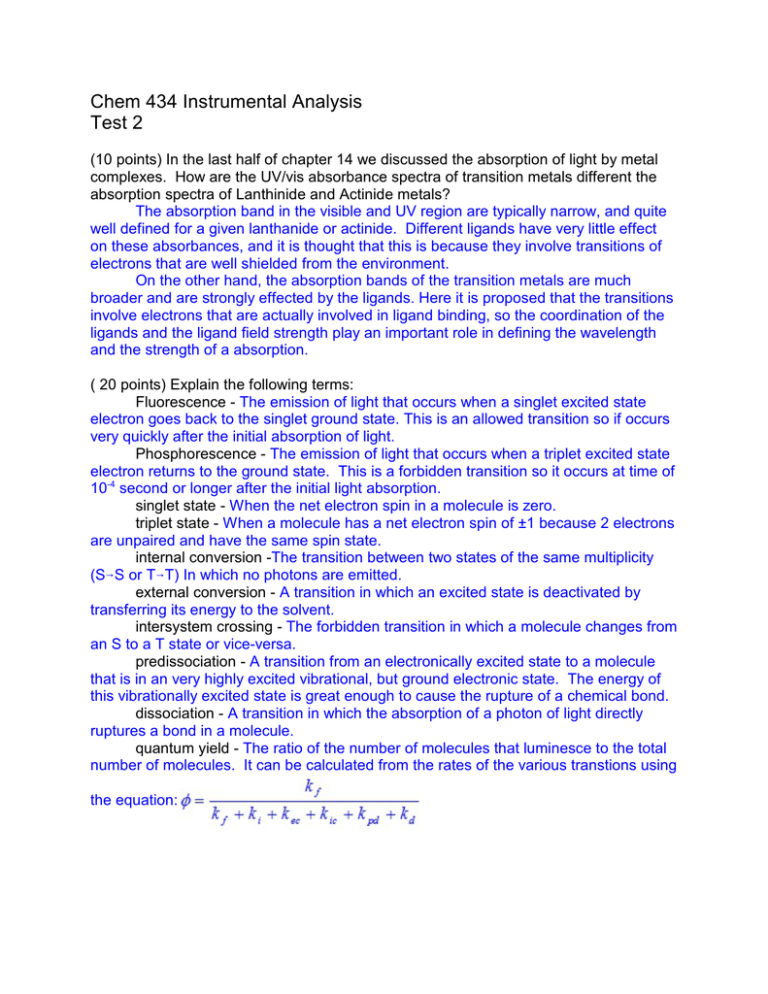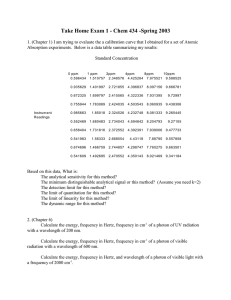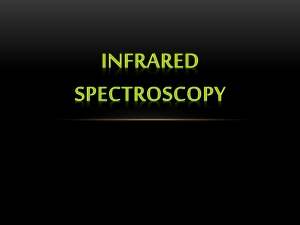Chem 434 Instrumental Analysis Test 2
advertisement

Chem 434 Instrumental Analysis Test 2 (10 points) In the last half of chapter 14 we discussed the absorption of light by metal complexes. How are the UV/vis absorbance spectra of transition metals different the absorption spectra of Lanthinide and Actinide metals? The absorption band in the visible and UV region are typically narrow, and quite well defined for a given lanthanide or actinide. Different ligands have very little effect on these absorbances, and it is thought that this is because they involve transitions of electrons that are well shielded from the environment. On the other hand, the absorption bands of the transition metals are much broader and are strongly effected by the ligands. Here it is proposed that the transitions involve electrons that are actually involved in ligand binding, so the coordination of the ligands and the ligand field strength play an important role in defining the wavelength and the strength of a absorption. ( 20 points) Explain the following terms: Fluorescence - The emission of light that occurs when a singlet excited state electron goes back to the singlet ground state. This is an allowed transition so if occurs very quickly after the initial absorption of light. Phosphorescence - The emission of light that occurs when a triplet excited state electron returns to the ground state. This is a forbidden transition so it occurs at time of 10-4 second or longer after the initial light absorption. singlet state - When the net electron spin in a molecule is zero. triplet state - When a molecule has a net electron spin of ±1 because 2 electrons are unpaired and have the same spin state. internal conversion -The transition between two states of the same multiplicity (S6S or T6T) In which no photons are emitted. external conversion - A transition in which an excited state is deactivated by transferring its energy to the solvent. intersystem crossing - The forbidden transition in which a molecule changes from an S to a T state or vice-versa. predissociation - A transition from an electronically excited state to a molecule that is in an very highly excited vibrational, but ground electronic state. The energy of this vibrationally excited state is great enough to cause the rupture of a chemical bond. dissociation - A transition in which the absorption of a photon of light directly ruptures a bond in a molecule. quantum yield - The ratio of the number of molecules that luminesce to the total number of molecules. It can be calculated from the rates of the various transtions using the equation: (10 points) Discuss the relative strengths and weaknesses of using UV/Vis absorption vs fluorescence for the determination of amounts of material in a sample. Since most compounds have absorbance band in the visible or ultraviolet region, most compounds can be quantified by absorption. To fluoresce, a molecule must be rigid, and have aromatic rings, so very few compounds can be determined with this method. While very few molecules fluoresce, it is a much better analytical technique because it is general at least 100-1000 times more sensitive than absorbance, and it has a much larger limit of linearity. Gaseous HCL exhibits an IR absorption at 2890 cm-1 due to the hydrogen chlorine stretching vibration. A. (10 points) Calculate the force constant of this bond. Let’s start with the reduced mass of HCl Mass of Cl in kg = 35.453x10-3/6.0x1023 = 5.9x10-26 kg Mass of H in kg = 1.008x10-3/6.0x1023 = 1.68x10-27 kg reduced mass of molecule (ì)= (5.9x10-26 kg ×1.68x10-27 kg)/(5.9x10-26 kg +1.68x10-27 kg) =1.633x10-27 kg Using the equation: 2890 = 5.3x10-12 sqrt(K/1.633x10-27) 2890/5.3x10-12 = sqrt(K/1.633x10-27) (2890/5.3x10-12 )2 = K/1.633x10-27 K = (2890/5.3x10-12 )2×1.633x10-27 =485.5 N/m Which is the right ballpark for a single bond B. (10 points) What would the wavenumber of the corresponding vibration be for DCl, where the proton is replaced with a deuterium atom. To reverse the above process we first need the reduced mass of the DCl molecule. Mass of Cl in kg = 35.453x10-3/6.0x1023 = 5.9x10-26 kg Mass of D in kg = 2.016x10-3/6.0x1023 = 3.36x10-27 kg reduced mass of molecule (ì)= (5.9x10-26 kg ×3.36x10-27 kg)/(5.9x10-26 kg +3.36x10-27 kg) =3.175x10-27 kg Now our equation for frequency reads: X = 5.3x10-13 sqrt(485.5/3.175x10-27) = 2073 cm-1 which is at a slightly lower frequency than our original frequency, and that makes sense since we are vibrating a heavier atom. (10 points) How many vibration modes would you expect to see for acetylene (C2H2) and peroxide (H2O2). Discuss why this kind of analysis sometimes predicts more, and sometimes less, vibrations bands than are actually observed. Acetylene is linear so we would use the equation: 3N-5 = 12-5 = 7 expected frequencies Peroxide is not linear so you use the equation: 3N-6 = 12-6 = 6 expected frequencies You sometimes observe less vibrational modes than you expect because: 1. Sometimes the symmetry o the molecules is such that the molecule’s dipole does not change, and if the dipole does not change, you cannot absorb IR energy. 2. Sometimes the frequencies of two vibrations overlap so you cannot distinguish between them. 3. Sometimes the absorptions are so low you cannot observe the bands 4. Sometimes the vibrations are simply outside of the regions you are detecting You may observe more vibrations than you predict because: 1. Sometimes vibrational modes combine to create overtone bands 2. Sometimes a photon can excite a combination band in which the single photon is exciting two different vibration modes simultaneously. (10 points) Discuss the different ways that an IR spectrum can be obtained from a solid sample. (List and describe as many different methods as you can) IR spectra that measure IR light absorbed when light is transmitted through a material: 1. Create a KBr pellet by combing 1 mg of your material with 100 mg of KBr, grinding together then squeezing together in a die to form a transparent window. 2. Dissolve is a solvent that will evaporate, and coat the liquid on the surface of a window. Then allow the solvent to evaporate and take the IR of the solid coated on the window. 3. Grind the solid with mineral oil or nujol for form a suspension, then place this suspension between two windows and take the IR IR spectra that measure IR light that is reflected off a solid: 1. Specular reflectance - measure IR light reflected of a smoothly polished surface of the material 2. Diffuse reflectance - Measure IR light reflected off a powder using a diffuse reflectance adapter 3. Attenuated Total Reflectance - As IR light passes from a crystal with a high refractive index(ZnSe or Si) to a material of low refractive index (your material) you get a reflection at the surface, and the light in this reflection shows absorbances of the material. There are at least two different adapters or IR instruments that use different light and sample geometries to achieve this measurement. (10 points) Why it is more difficult to obtain quantitative data in the IR using Beer’s law than in the UV/Visible region. (Discuss several different reasons) 1. It is difficult, but not impossible to make an IR cell with a known pathlength. 2. If you do make such a cell it is almost impossible to make a second matched cell. 3. Beer’s law only works when you apply it to a very narrow range of wavelengths at an absorption maxima. Because IR bands are so narrow, the instrument’s band width is usually larger than the absorption maximum. 4. The modern FTIR instrument is a single beam design, not a double beam design, so the single beam instrument cannot obtain the accuracy and precision of a double beam instrument. 5. The baseline in an IR spectrum is not flat and is usually not zero, so finding the true signal - baseline is difficult. (10 points) In Raman spectroscopy one can find IR vibrations using UV or visible light. Discuss how this is done. In this explanation include a definition of both stokes and antistokes lines. In Raman spectroscopy a sample absorbs light from a laser tuned to a single wavelength in the visible or UV region. The light that is scattered from this material is detected at an angle of 90o from the incident light. Since the laser light is not at a frequency that can be absorbed by the sample, no light absorption can occur, and the light must be radiated off the material by scattering. Over the time that the light interacts with the material, it is possible for the molecule of the sample to vibrate. As the molecule vibrates, it can either add or remove a tiny bit of energy from the photon of the scattered light. If the molecule is in a vibrationally excited state and passes that energy to the scattered photon as it drops to a vibrational ground state, the scattered photon has a slightly higher frequency, and this is referred to as an Anti-Stokes line. If the molecule uses a little of the incident photon’s energy to kick itself into a vibrationally excited state, then the scattered light has a slightly lower energy or frequency and this results in a Stokes line.









